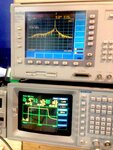BorisBJL10
Newbie level 5

Hi everybody,
I'm trying to prototype an exciter board for a pulsed beacon transmitter operating at 960-1000 MHz band.
I've built a board which uses two Hittite HMC221A switches employed as SPST pulse RF modulator after PLL and two amplifier stages
Switch operates at approx. +18 dBm power level.
The issue I've got is a pulsed RF signal spectrum sideband contamination, which is seen as an extra unwanted 'tail' of Fourier 'bells' at frequencies only below main signal, spanning for almost 50 MHz more that it should. Pulses are 6 uS wide and 1600 Hz PRF. Attached is a screenshot from spectrum analyzer, at 200 MHz span.
PLL sythesizer's CW signal before switch is totally and knowingly perfect.
I'd love to get your comments on possible causes of this issue. Where could this crap come from?
Thanks.

I'm trying to prototype an exciter board for a pulsed beacon transmitter operating at 960-1000 MHz band.
I've built a board which uses two Hittite HMC221A switches employed as SPST pulse RF modulator after PLL and two amplifier stages
Switch operates at approx. +18 dBm power level.
The issue I've got is a pulsed RF signal spectrum sideband contamination, which is seen as an extra unwanted 'tail' of Fourier 'bells' at frequencies only below main signal, spanning for almost 50 MHz more that it should. Pulses are 6 uS wide and 1600 Hz PRF. Attached is a screenshot from spectrum analyzer, at 200 MHz span.
PLL sythesizer's CW signal before switch is totally and knowingly perfect.
I'd love to get your comments on possible causes of this issue. Where could this crap come from?
Thanks.





